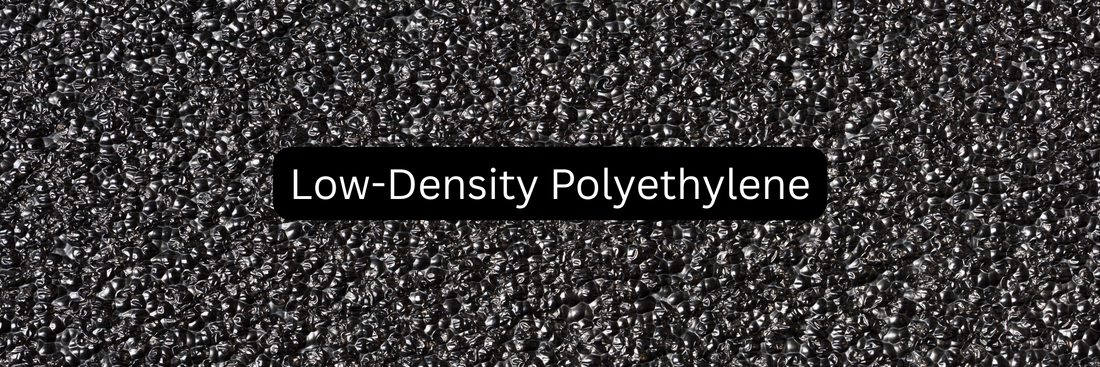In today’s world, packaging materials need to be lightweight, durable, cost-effective, and versatile. LDPE meets all these requirements, making it a favorite choice for industries ranging from food and beverage to healthcare and retail.
Unlike rigid plastics, LDPE is soft, flexible, and transparent, allowing it to be used in applications where clarity and ease of sealing are important. Whether it’s the plastic wrap covering your sandwich or the squeeze bottle of honey in your kitchen, LDPE is likely part of the package.
What is LDPE?

LDPE is a thermoplastic polymer made from the monomer ethylene. It has a low density compared to other polyethylene types, which gives it its signature flexibility and softness.
How LDPE is Made
LDPE is produced through a high-pressure polymerization process that uses free radical polymerization. This process creates a highly branched molecular structure, which reduces density and increases flexibility.
Common Forms of LDPE Plastic
- Film and sheets – Used for grocery bags, produce bags, shrink wrap.
- Molded items – Such as lids, squeeze bottles, and caps.
- Coatings – For paper cups, cartons, and packaging materials.
Properties of LDPE Plastic

LDPE is known for its combination of light weight, flexibility, and chemical resistance. Key properties include:
- Flexibility – Can bend and stretch without breaking.
- Transparency – Ideal for clear packaging.
- Moisture resistance – Protects products from water damage.
- Chemical resistance – Can withstand many acids and alcohols.
- Low melting point (105–115°C) – Good for sealing, but not suitable for high-temperature applications.
These properties explain why LDPE packaging is so common in the food industry.
Is LDPE Plastic Safe?
When it comes to food safety, LDPE is considered one of the safest plastics available.
- Food-grade approved – Many LDPE products meet FDA and EU food-contact safety standards.
- BPA-free – LDPE does not contain bisphenol A, a chemical linked to health concerns.
- Non-toxic – Safe for everyday food storage and handling when used as intended.
However, because of its low melting point, LDPE should not be used for high-heat cooking or microwave applications. Overheating can cause deformation and potential leaching of additives.
LDPE in Packaging
LDPE Film & Wrap
LDPE film is one of the most common forms of this material. It’s used for:
- Grocery bags and produce bags
- Food wrap and shrink wrap
- Protective packaging for electronics and consumer goods
Its flexibility, lightweight nature, and moisture resistance make it ideal for products that require a protective yet economical covering.
LDPE Bottles & Containers
LDPE’s squeezable texture makes it perfect for:
- Honey and mustard bottles
- Cosmetic tubes
- Condiment squeeze bottles
These containers are easy to handle, resistant to cracking, and cost-effective to produce.
Benefits of LDPE Packaging
- Lightweight – Reduces shipping costs.
- Moisture barrier – Extends product shelf life.
- Flexibility – Prevents breakage and damage during transportation.
- Sealability – Works well with heat-sealing for secure packaging.
LDPE Recycling

Can LDPE Be Recycled?
Yes, LDPE can be recycled, it is identified by Resin Identification Code #4. However, not all curbside programs accept it due to sorting challenges and contamination risks.
Recycling Process
- Collection – Through store drop-off points or specialized recycling facilities.
- Sorting and cleaning – Removing food residue and labels.
- Shredding – Cutting LDPE into smaller flakes.
- Reprocessing – Melting and forming pellets for reuse.
Products Made from Recycled LDPE
- Outdoor furniture
- Garbage bin liners
- Flooring materials
- Shipping envelopes
Challenges in LDPE Recycling
- Food contamination
- Limited curbside acceptance
- High transportation costs for lightweight film

LDPE vs HDPE
| Feature | LDPE | HDPE |
|---|---|---|
| Density | Low | High |
| Flexibility | High | Low (more rigid) |
| Transparency | Clear | Opaque |
| Common Uses | Bags, wraps, squeeze bottles | Milk jugs, detergent bottles |
| Recycling Code | #4 | #2 |
LDPE is chosen when flexibility and clarity are needed, while HDPE is preferred for rigid, durable applications.
Environmental Impact & Sustainable Alternatives
While LDPE is reusable and recyclable, it still contributes to plastic waste if not properly managed.
- Environmental Concerns – Long degradation time; potential microplastic pollution.
- Sustainable Alternatives – Compostable films, paper-based packaging, reusable silicone wraps.
- Corporate Initiatives – Many brands are now collecting LDPE waste and reprocessing it into new packaging.
FAQ
Q1: What is LDPE used for most?
Grocery bags, food wraps, and squeeze bottles.
Q2: Is LDPE biodegradable?
No, but it is recyclable under the right conditions.
Q3: Can LDPE hold hot liquids?
It’s not ideal for hot liquids due to its low melting point.
Q4: How can I identify LDPE plastic?
Look for the recycling symbol with the number 4 inside the triangle.
Understanding Right Recycling Symbols
Conclusion
LDPE, or Low-Density Polyethylene, is a versatile, flexible, and widely used plastic with applications ranging from packaging films to bottles. It’s considered safe for food contact, is lightweight, and offers excellent moisture resistance.
While LDPE is recyclable, the process requires proper collection, cleaning, and sorting. To reduce its environmental impact, consumers and businesses should recycle wherever possible and explore sustainable alternatives.
Responsible use and recycling of LDPE can help reduce plastic waste while still enjoying the benefits this material offers.




